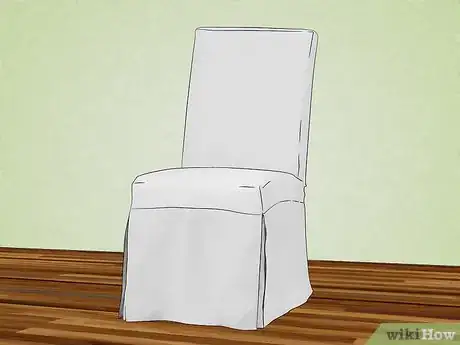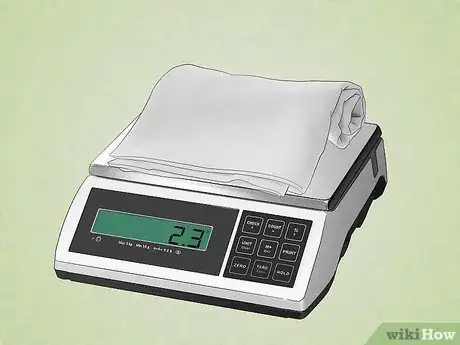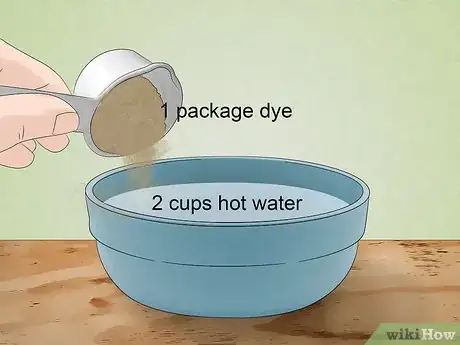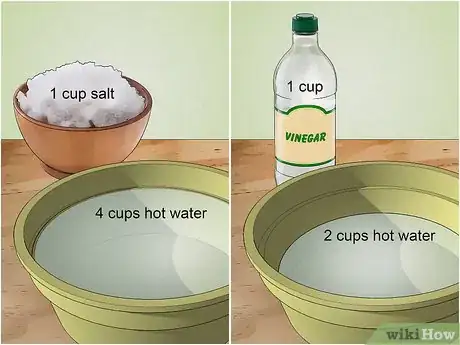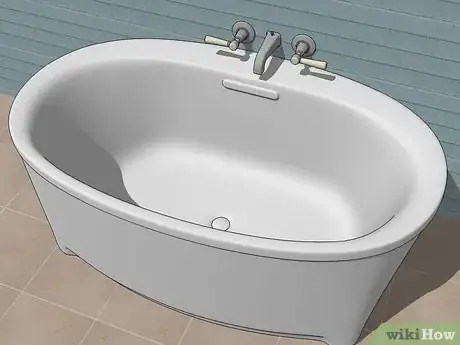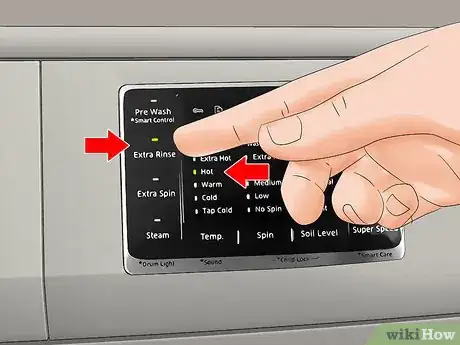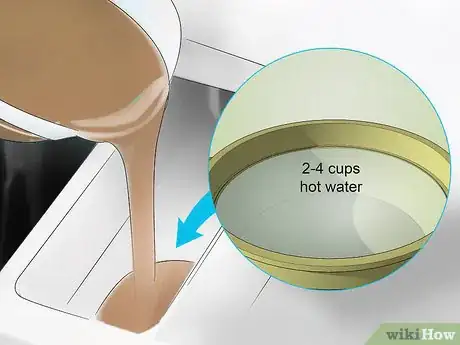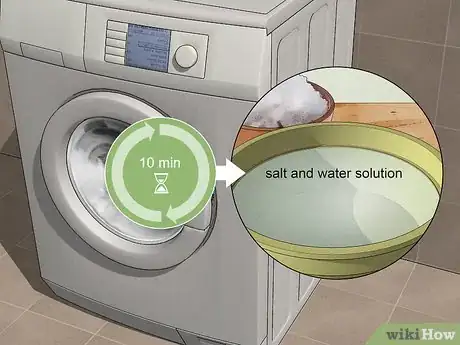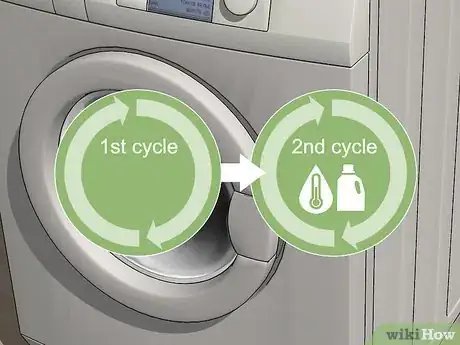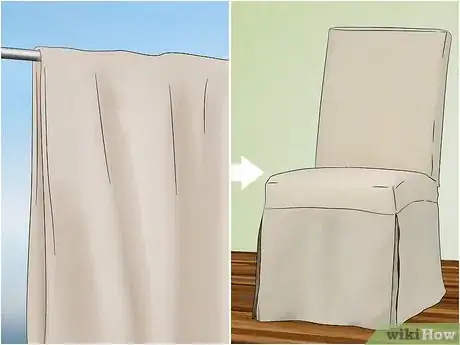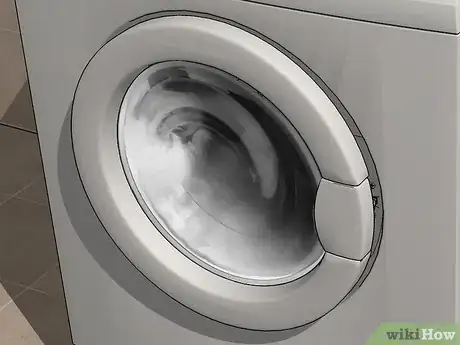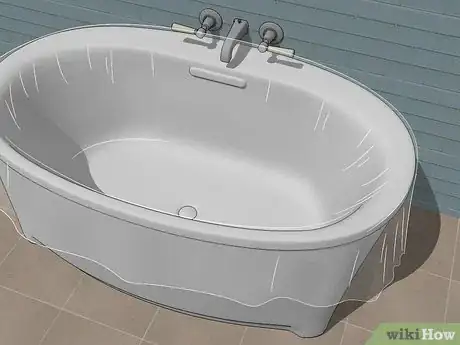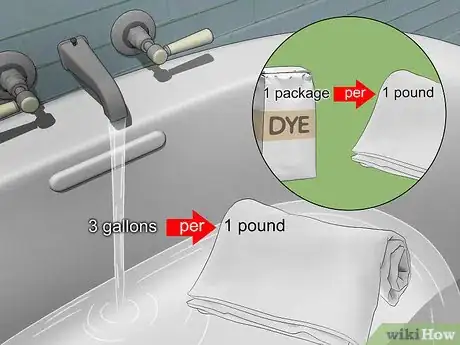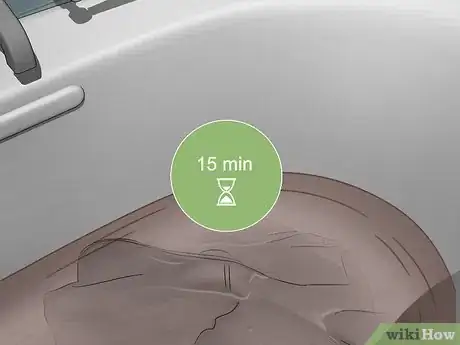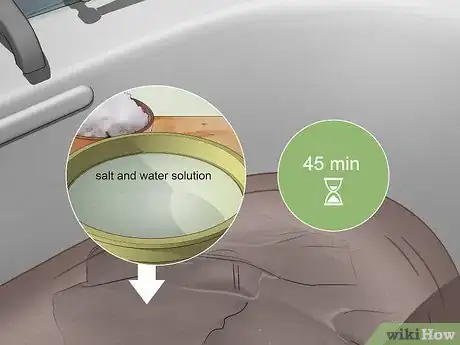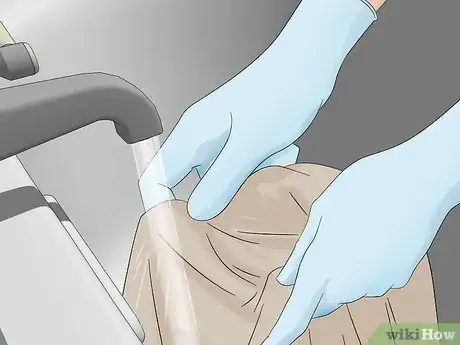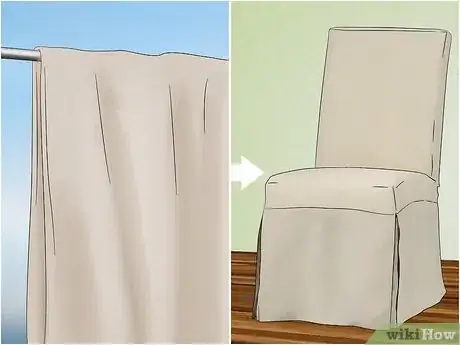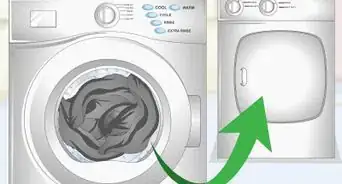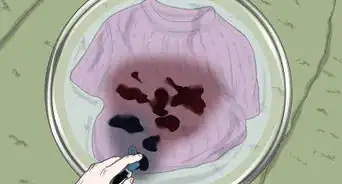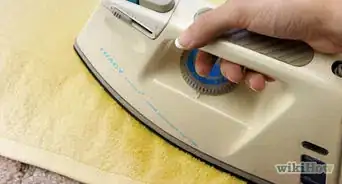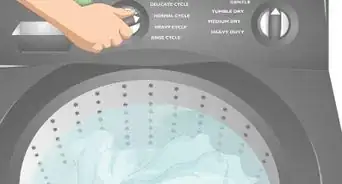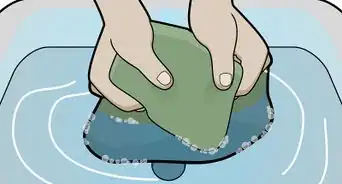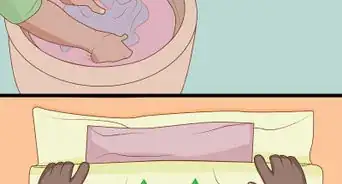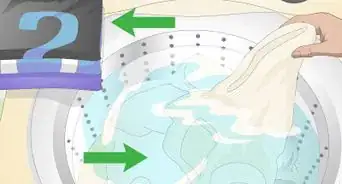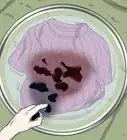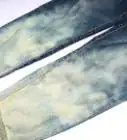X
This article was co-authored by wikiHow Staff. Our trained team of editors and researchers validate articles for accuracy and comprehensiveness. wikiHow's Content Management Team carefully monitors the work from our editorial staff to ensure that each article is backed by trusted research and meets our high quality standards.
This article has been viewed 23,947 times.
Learn more...
Dyeing couch or chair slipcovers is a great way to upgrade the look of your room. You can use this technique to refresh a faded color, or to update a mundane color, like white or beige. Once you prepare the cover and dye, you can then proceed to dyeing it in the washing machine or in a bathtub.
Steps
Method 1
Method 1 of 3:
Preparing the Cover and Dye
-
1Choose a white slipcover if you want a custom color. Dye is translucent, so it will only add to whatever color is already there. If you want to get the color on the package, choose a white slipcover. If you want a more muted color, however, you could try a light gray or beige slipcover.
- You can use fabric dye to refresh a faded slipcover. In this case, match the dye color to the slipcover color.
- Solid colors will work the best, but you can experiment with patterns. The pattern will show up, but the dye may tint lighter colors.
-
2Weigh the slipcover to find out how much dye and water you’ll need. A regular scale may do the trick, but a postal scale might be better. If you kept the packaging from the slipcover, read the label; sometimes the manufacturer writes the weight in addition to the dimensions.
- Knowing the weight is important, because if you don’t use enough dye, the color will be too light.
Advertisement -
3Buy fabric dye based on the slipcover weight and fabric content. In most cases, you’ll need 1 package of powdered dye or 1/2 bottle of liquid dye for every 1 pound (454 g) of fabric.[1] Next, read the tag on the slipcover to find what it is made out of. You can dye just about any material, as long as you use the right type of dye.
- Regular fabric dye will work on natural fabrics, such as cotton and linen.
- If your slipcover is made from polyester, however, you should use polyester fabric dye instead, such as iPoly or Rit Dyemore.
- If your slipcover is made from a natural and synthetic blend, stick with a polyester dye.
-
4Wash the slipcover without fabric softener, and don't dry it. Washing the fabric is important because it will remove any dirt or chemical coatings that might prevent the dye from sticking. Don’t dry the slipcover, however. – Leaving it wet will ensure that the fabric takes the dye evenly.[2]
- You don’t want to use fabric softener because it will prevent the dye from adhering.
- Be sure that you weigh the slipcover before you get it wet; it will be heavier once you soak it, which won’t give you an accurate weight.
-
5Dissolve powdered dye in 2 cups (470 mL) of hot water. Liquid dye is all ready to go, but powdered dye needs to be dissolved first, otherwise, it won’t mix properly in the dye bath. Simply fill a pitcher with 2 cups (470 mL) of hot water, then add the powdered dye. Stir the solution until no granules remain.
- This is enough for 1 package of powdered dye. If you are using more dye, then you'll need to use more water.
- Although liquid fabric dye is ready to use as-is, it would be a good idea to shake the bottle before you open it.
-
6Prepare a salt water, soda ash, or vinegar solution, based on the fabric. Read the instructions that came with your dye to find out which you should use. In most cases you'll need salt for cotton or linen, and vinegar for silk or nylon. Some types of dye will need soda ash, which you can get in the tie dye section of a craft or fabric store. The amounts listed below are for 1 package of powered dye or 1/2 bottle of liquid dye.
- Salt: Mix 1 cup (273 g) of table salt and 4 cups (950 mL) hot water for natural fibers, such as cotton and linen.[3]
- Soda ash: Read the instructions that came with the dye. In most cases, you'll use 1 cup (273 g) of soda ash and 4 cups (950 mL) hot water.
- Vinegar: Combine 1 cup (240 mL) of white vinegar and 2 cups (470 mL) of hot water.
-
7Plan to dye the slipcover in a washer if you want a convenient option. You need to stir the fabric often as it is dyeing in order for the color to turn out consistent. The good thing about washing machines is that they already do the agitating for you!
- Make sure that the washing machine is big enough for the slipcover. The slip cover needs to be able to move freely in the washer.
- Click here to learn how to dye the slipcover in a washing machine.
-
8Use a bathtub if you don't own a washing machine. This is also a good option if the washer is too small for the slipcover. Keep in mind that this method works best for natural fibers, such as cotton and linen. It’s not recommended for synthetics, as the dye used for those needs to be kept at a constant boil.
- Click here to learn how to dye the slipcover in a bathtub.
- If you are working with synthetics and your washer is too small, you can try going to a laundromat.
Advertisement
Method 2
Method 2 of 3:
Using a Washing Machine
-
1Select a hot water cycle with an extra rinse. Put the slipcover into the washer first. Close the washer and select a hot water cycle with an extra rinse. If you can't select an extra rinse cycle, choose a setting that will add about 30 minutes to the cycle.[4]
- If possible, set the water level to the highest level available.
-
2Add your liquid dye into the dispenser, then flush it with hot water. Pour your fabric dye directly into the detergent dispenser. Follow up with some hot water. If you're using bottled fabric dye, you can simply pour 2 bottles’ worth of water; otherwise, 2 to 4 cups (470 to 950 mL) of hot water will do.[5]
- This will help remove the dye residue from the compartment and prevent it from staining.
- Add 1 tablespoon (15 mL) of laundry detergent. While not absolutely necessary, this will help the item dye more evenly.
- The amounts in this step are for 1/2 bottle of liquid fabric dye or 1 box of prepared powdered dye.
-
3Let the cycle run for 10 minutes, then add the salt water solution. Close the washer first, then start the cycle and let it run for 10 minutes. Pause the cycle, then pour the salt water solution you prepared earlier into the dispenser.[6]
- If you prepared a soda ash or vinegar solution, use that instead.
- Make sure that you are pouring the solution into the detergent dispenser.
-
4Finish the cycle, then do another cycle with warm water and detergent. Once you have the salt water solution in the dispenser, let the cycle finish. Do a second cycle, this time using warm water and mild detergent. It would be even better if you added an extra rinse cycle.[7]
- The second warm-water cycle will ensure that any excess dye is rinsed out.
- How much detergent you use depends on the brand that you are using, so read the instructions on the bottle.
-
5Dry the slipcover, then put it on the chair while it is still damp. You can use a clothes dryer or hang the slipcover up to dry. Once it is about 90% dry, put it onto the chair (or couch), and let it finish drying. This will help reduce wrinkles.[8]
- Be sure to empty out the lint trap if you used a dryer.
-
6Clean your washer using a hot water, high-level setting. You can also add some old rags you don't mind staining into the drum. Add 2 cups (470 mL) of bleach to the dispenser and run another full cycle. At the end of the cycle, wipe down the inside of the drum and dispenser with an old rag.[9]
- Use standard, household bleach or laundry bleach.
- If you don't have bleach, use 2 cups (470 mL) of vinegar instead. Do not mix bleach and vinegar, or this will create a dangerous chemical reaction.
Advertisement
Method 3
Method 3 of 3:
Using a Bathtub
-
1Line the bathtub with a plastic sheet. While it is not absolutely necessary to line the bathtub first, it is highly recommended as it will reduce the chances of the dye staining the tub. Simply tuck a large, plastic sheet or tablecloth into the tub, then tape down the edges.[10]
- You can buy plastic tablecloths in party supply stores. Home improvement stores should sell plastic sheets. Make sure it’s water-tight.
- Duct tape works especially well here, but you can use packaging tape as well. The goal here is to line the tub and prevent the dye water from touching it.
-
2Fill the tub with hot water, then add the dye. Read the instructions on the dye package to find out how much water you should use. Once you have the tub filled, pour the dye into the water, then give it a stir.
- Consider adding 1 tablespoon (15 mL) of liquid detergent for every 1/2 bottle or 1 box of powered dye. This will help the slipcover dye more evenly.
- Plan on using 3 gallons (11 L) for every 1 pound (454 g) of fabric.
-
3Add the slipcover and let it soak for 15 minutes, stirring often. Put on a pair of plastic gloves, then push down on the slipcover so that the fabric is completely submerged. Use a sturdy stick or paddle to stir the dye bath.[11]
- You don’t have to stir it continuously; you can stir it every 5 minutes or so. The stirring is important as it will help the fabric dye evenly.
-
4Add the fixative solution, then soak the slipcover for 45 minutes. The fixative solution is the salt, vinegar, or soda ash solution that you prepared earlier. Pour that into the water, then give the water a stir. Let the slipcover sit in the tub for 45 minutes, stirring it every 5 to 10 minutes.[12]
-
5Rinse the slipcover until the water runs clear. You can do this in the tub or in a washing machine. If you choose to do it in the tub, move aside the plastic lining and drain the tub first. If you choose to do it in the washing machine, run a cycle without any detergent. Plan on rinsing the slipcover at least 5 times in the tub or 3 times in the washer.[13]
- To rinse the slipcover in the tub, you can either hold it under running water, or soak it in fresh batches of water for a few minutes at a time.
- To rinse the slipcover in the washing machine, simply run it through 3 rinse cycles.
-
6Dry the slipcover partway, then put it on the chair while it's still damp. Depending on what type of fabric it is made from, you can dry it in the dryer, or hang it up to dry instead. To reduce wrinkles, wait until it is about 90% dry, then put it on your chair or couch.
- If the bathtub got stained, you can remove the stain using a paste made from baking soda and water. You can also give it time; it will fade a little each time you shower.
Advertisement
Things You'll Need
- Slipcover
- Fabric dye
- Hot water
- Salt, soda ash, or vinegar
- Pitchers
Using a Washing Machine
- Washing machine
- Bleach
- Mild laundry detergent
- Liquid detergent (optional)
Using a Bathtub
- Bathtub
- Plastic sheet
- Duct tape
- Plastic gloves
- Sturdy stick or paddle
- Liquid detergent (optional)
References
- ↑ https://www.apartmenttherapy.com/how-to-dye-textiles-in-a-front-loading-washing-machine-apartment-therapy-tutorials-218301
- ↑ https://www.apartmenttherapy.com/how-to-dye-textiles-in-a-front-loading-washing-machine-apartment-therapy-tutorials-218301
- ↑ https://www.apartmenttherapy.com/how-to-dye-textiles-in-a-front-loading-washing-machine-apartment-therapy-tutorials-218301
- ↑ https://www.apartmenttherapy.com/how-to-dye-textiles-in-a-front-loading-washing-machine-apartment-therapy-tutorials-218301
- ↑ https://www.apartmenttherapy.com/how-to-dye-textiles-in-a-front-loading-washing-machine-apartment-therapy-tutorials-218301
- ↑ https://www.apartmenttherapy.com/how-to-dye-textiles-in-a-front-loading-washing-machine-apartment-therapy-tutorials-218301
- ↑ https://www.apartmenttherapy.com/how-to-dye-textiles-in-a-front-loading-washing-machine-apartment-therapy-tutorials-218301
- ↑ https://allforthememories.com/how-to-dye-a-sofa-slipcover/
- ↑ https://www.apartmenttherapy.com/how-to-dye-textiles-in-a-front-loading-washing-machine-apartment-therapy-tutorials-218301
About This Article
Advertisement
